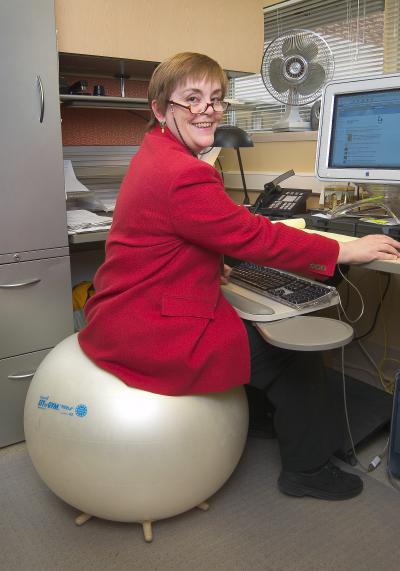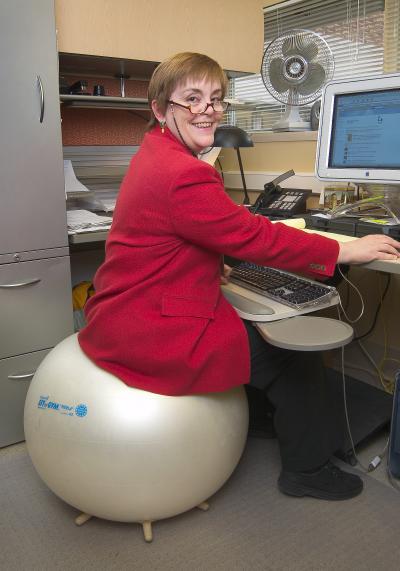December 4, 2003
True confessions of a volunteer lab rat
I wish I could say that I got into being a lab rat for some noble purpose, like the furtherance of great scientific quests, or a desire to help find a cure for some dread disease that has endangered humanity for countless millennia, or even a wish to find the answer to the great universal Why? To be honest, I wanted the exercise ball.
One of the benefits of working in UW Health Sciences Center is being able to walk down the hall on the fourth floor of T Wing and see bulletin boards loaded with requests for volunteers to participate in all sorts of clinical research studies. While some of the studies pay money, others provide medical care for specific ailments and still others provide nothing more than carfare and an interesting experience. The current crop of studies posted on sheets of colored paper flapping in between ads for used cars and empty apartments includes studies on everything from normal sleep patterns and immunology of the blood to arthritis, whiplash, miscarriage, marriage, hormones, memory and lots, lots more. If the selection there or at
http://www.washington.edu/healthresearch/ makes your head spin, don’t worry – there’s a study on that, too. The Web site is maintained by the School of Medicine’s Office of Clinical Research and is open for all units in health sciences schools to list studies seeking volunteer participants.
The first study I signed up for was run by some graduate students in physical therapy. They wanted to show whether those big exercise balls people use to enhance balance could help strengthen back muscles, leading to reduced lower back pain. It was almost too easy to sign up: I had to fill out a questionnaire about my back, do a short telephone interview, and then a grad student showed up at my cubicle, blew up the ball and showed me how to sit on it for up to two hours a day. The ball was the hit of the office, and even went to some managerial meetings when I was on vacation. It helped my back and it helped the grad students get their degrees. What more can you ask of a bouncy piece of plastic?
The next study was a little less fun. It involved filling out still more questionnaires (who fills these out for the real lab rats?) and having an MRI (magnetic resonance imaging) study done while hyperventilating. The aim of the study was to discover how people who suffer from anxiety attacks differ in terms of brain chemistry from people who don’t suffer panic. An MRI is not for anyone who is scared by small spaces and sudden loud noises. I got through it by redecorating an unsuspecting friend’s house in my imagination – always the cheapest way to do any interior design. And it was interesting to try to hyperventilate, after years of not doing so.
My most recent study entailed two exams by top professionals who are interested in jaw pain, with an MRI and a CT scan sandwiched in between. After filling out two sets of questionnaires, I received a complete analysis of why my jaw joints sometimes hurt – no big surprises, but with that information and the fee the study paid, I was able to pay off a bill while I considered some medical options if my jaws continue to hurt. And who knows: the study, once it is completed 800 participants from now, may result in a more accurate way of measuring and eventually curing this kind of chronic discomfort.
An actual lab rat can’t be coaxed into sitting on a plastic ball for a few hours a day – even if they ever suffer from lower back or upper tail pain. Nor can a rodent hyperventilate on cue. Certainly any malocclusions rats may have tend to be self-correcting. And humans are definitely much better at filling out questionnaires, even if the real rats were willing and able to do so. There is a place for human lab rats in medical research and I’ll keep hoping there’s room for me. It’s a great way to learn something new.


